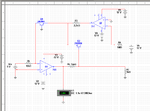littledog
Newbie level 5
I'm involved in an educational project and I want to design a logarithmic amplifier based on ua741. Following capture shows my circuit:

Diode is 1N4148
Resistor Value is 33Kohms
And the results in lab and simulating don't match the results using the following formula:

Vin= 6v
Vdd+=15v
Vdd-=-15v
Vt= 0.026 v
Is (Saturation Current = Reverse current) = 25 nA (I took from diode datasheet)
Even simulating results and lab results don't match.
Vin Simulating (Using multisim) ____Lab _____Formula
6v=> -0.552 _________________-0.523____ -0.231
5v=> -0.547 _________________ -0.516 ___ -0.226
4v=> -0.541 _________________-0.505_____-0.221
I don't know if I'm applying correctly the formula or if this is the formula I have to use.
Is there a way to check which parameters use Multisim to simulate ua741 or diode 1N4148?
Thank you very much in advance,

Diode is 1N4148
Resistor Value is 33Kohms
And the results in lab and simulating don't match the results using the following formula:
Vin= 6v
Vdd+=15v
Vdd-=-15v
Vt= 0.026 v
Is (Saturation Current = Reverse current) = 25 nA (I took from diode datasheet)
Even simulating results and lab results don't match.
Vin Simulating (Using multisim) ____Lab _____Formula
6v=> -0.552 _________________-0.523____ -0.231
5v=> -0.547 _________________ -0.516 ___ -0.226
4v=> -0.541 _________________-0.505_____-0.221
I don't know if I'm applying correctly the formula or if this is the formula I have to use.
Is there a way to check which parameters use Multisim to simulate ua741 or diode 1N4148?
Thank you very much in advance,

